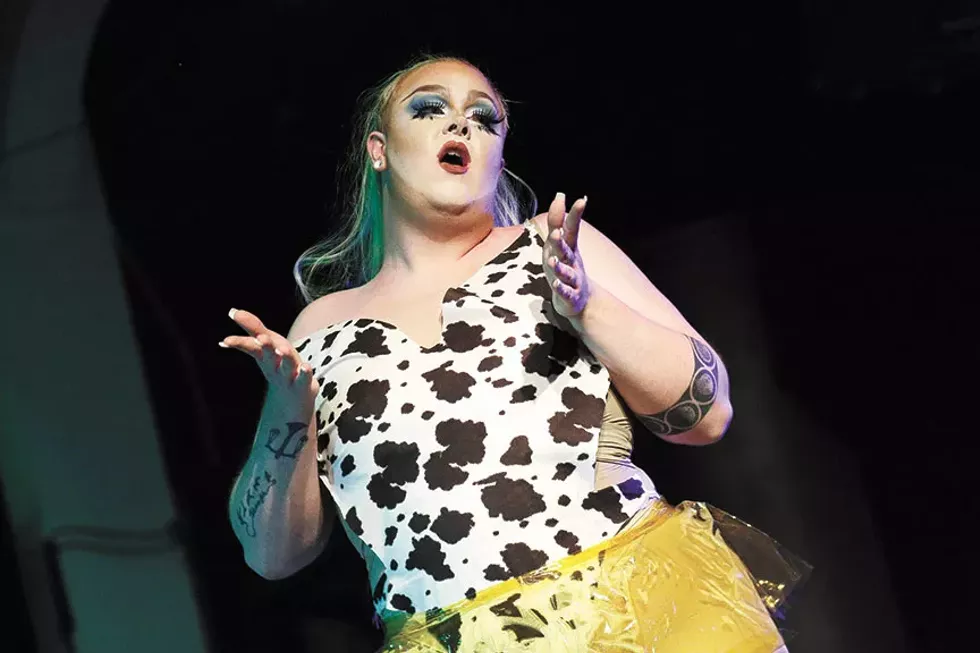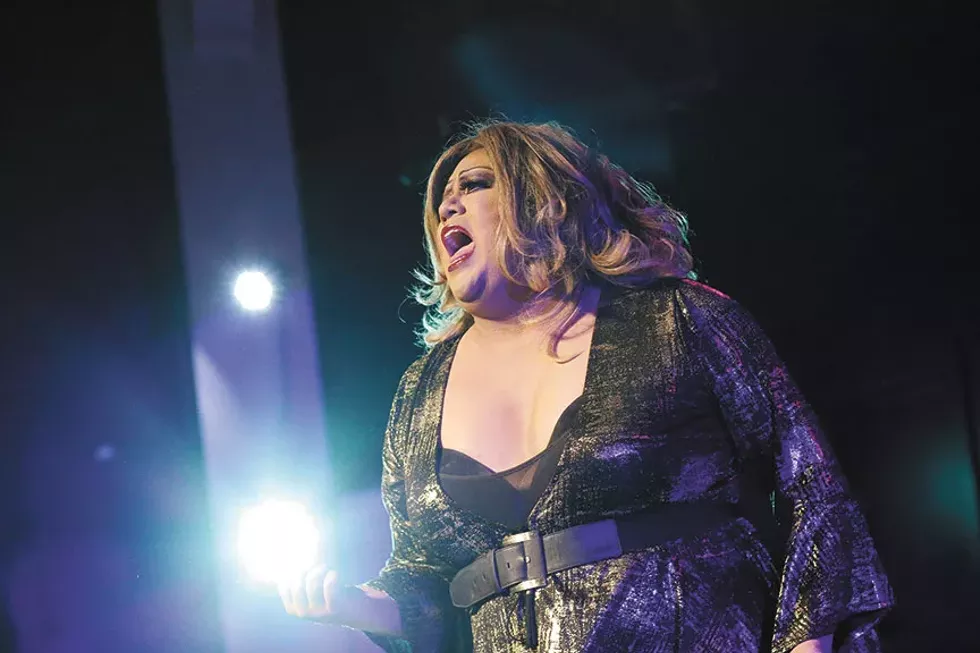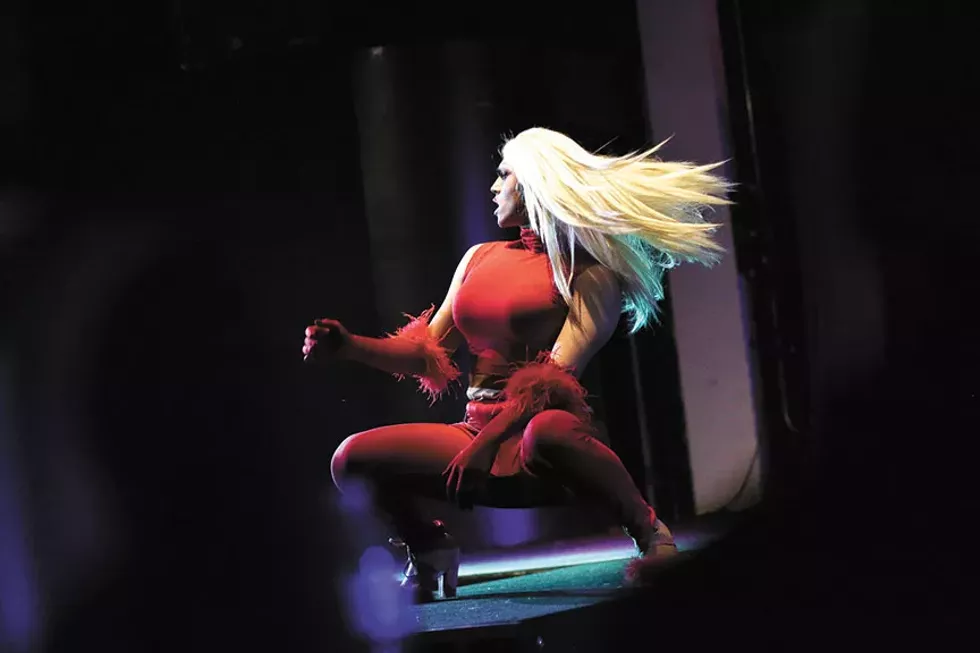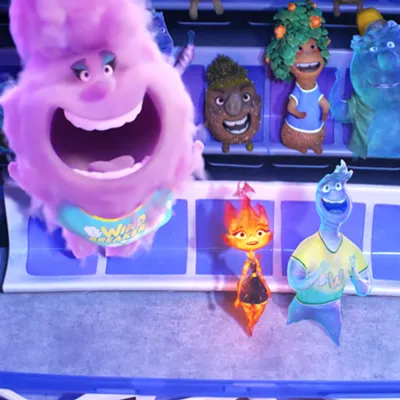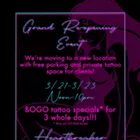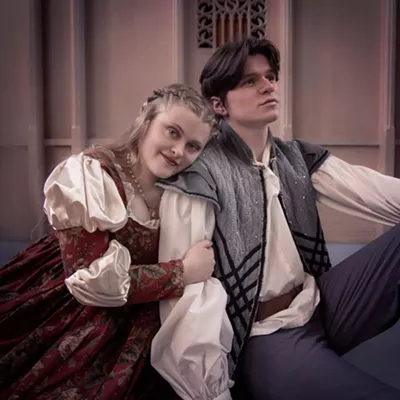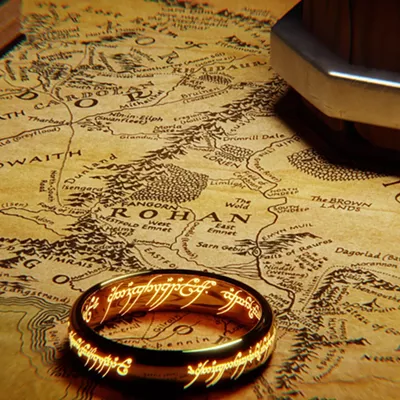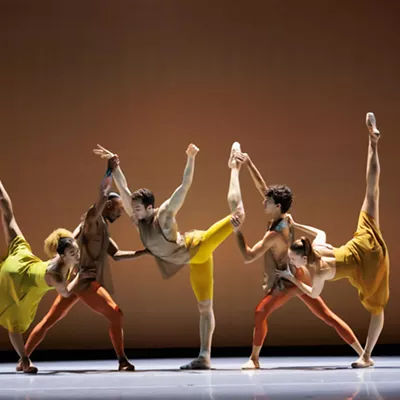It only takes an hour for Jason Johnson, a soft-spoken 50-year-old man, to completely transform into Nova Kaine, a female torch singer who can lip sync the hell out of a Judy Garland song and is always equipped with a killer zinger.
"Nova is Jason with three more cocktails, saying things Jason wishes he could," Johnson explains. He describes his drag queen persona as existing somewhere between the wicked Alexis Carrington from the '80s soap Dynasty and the bumbling Aunt Clara on Bewitched.
In the three decades he has been performing in drag, Johnson has honed his makeup regimen down to a science. The process starts with a lot of beige-colored foundation on his face and chest. He contours his cheeks and jaw with a slightly darker liquid foundation, creating a narrower, more conventionally feminine look. Then there's the lip liner, eyeliner, elaborate eye makeup (he uses the edge of his credit card to keep the lines straight), painted-on eyebrows (about an inch higher than his own) and false eyelashes. A whole lot of powder keeps everything from smudging. And the finishing touches: a wig, topped by a three-pound crystal-studded crown.

If you've been to a Spokane drag show in the last 15 years, it's highly likely that you've seen Johnson-as-Nova in the role of emcee. He got his first regular drag gig at Dempsey's, the Spokane gay bar that closed its doors in 2011, and later performed at the Spokane Valley bar Holly Rock and the downtown nightclubs Spotlight Lounge and Irv's (all of which have also gone out of business). Nova now emcees weekly drag shows and karaoke at the Blind Buck, one of four Spokane bars that regularly host drag events — the others being nYne, JR's Bar-N-Grill and the all-ages music venue the Pin.
You'd never know it, but Johnson actually considers himself somewhat agoraphobic when he removes the lashes and mascara, despite his decades working in broadcast radio.
"But when I'm in drag and have that microphone, I'm in control," Johnson says. "It's my security blanket. The character kind of takes over at that point."
That's typical of so many practitioners of drag: It's a proudly flashy form of entertainment that allows its performers to disappear into outlandish costumes and over-the-top antics, and it has fluorished within the LGBTQ community for generations.
"Drag is theater unto itself," Johnson says, "and that's what I really enjoy about it."
A Brief Herstory
That carefree commitment to the theatrical is the driving force behind so many performers within the local drag scene, and it's a chance for people to disappear into female alter egos that are essentially heightened, more confident versions of themselves.
But what is drag, exactly?
It's probably safe to say that our culture's collective notion of a drag queen is an old-fashioned — though not entirely inaccurate — one: A gay man dressed as a woman, traditionally lip-synching to the work of well-known female vocalists, complete with choreography, costumes and extravagant makeup.
At its core, the art of drag involves screwing around with conventional gender norms — as illusion, as camp, as pageantry — and as mainstream perceptions of gender and sexuality become more fluid, so, too, do the prescribed definitions of drag. Each drag performer has their own persona, style and bag of tricks, and an average drag night isn't unlike an old-fashioned variety show with music, comedy and dance.
Drag is still something of an underground artform, but it has occasionally bubbled up into the contemporary mainstream. In the 1970s, films like Pink Flamingos, starring the late drag queen Divine, and the gender-bending The Rocky Horror Picture Show became cult phenomena. The documentary Paris Is Burning, a snapshot of the predominantly black and Latinx queens of 1980s New York, cemented a lot of drag lingo and traditions, and its subjects' hand movement-heavy style of dancing known as voguing was infamously co-opted by Madonna.
Crowd-pleasing movies like To Wong Foo Thanks for Everything, Julie Newmar and The Adventures of Priscilla, Queen of the Desert have featured drag queens as lovable, relatable protagonists. And then there's the enterprising RuPaul, host of the hugely popular, Emmy-winning reality competition series RuPaul's Drag Race, in which up-and-coming drag queens compete in fashion, comedy and choreography challenges.
But there are still misconceptions about the function of drag, and about the fundamental difference between gender identity and the art of female impersonation. Paul Martens, whose drag persona Marry A'Botumn is a member of the "cast" at nYne, says he was just explaining this to his father just a couple weeks ago.
"He's an old-school, Irish-Italian Catholic, and he has a hard time differentiating between what's trans versus what's drag," Martens says. "I'm a drag queen. It's strictly for entertainment. I'm not a woman, I don't pretend to be a woman [when I'm not performing]. I don't identify as a woman or anything like that."
But drag performers do cover the spectrum. They're not just cisgender gay men: There are plenty of transgender and non-binary drag queens, as well as AFAB (or "assigned female at birth") performers, and drag kings, who tend to be women achieving a male illusion. There are even some straight men who do drag.
Johnson was one of them, at least for a while. He was raised on a ranch in Wyoming in a conservative Episcopalian family, and was the captain of his high school's rodeo team. He first got into drag in 1987 when, as a theater student at the University of Wyoming, he entered into an Aerosmith-themed "Dude Looks Like a Lady" drag contest at a cowboy bar in Laramie.
He came out as gay to his family around that same time, but upon being threatened and intimidated by his father, he instead married a woman and had three kids, doing drag all the while.
"I've since come out of the closet again," Johnson says, "and I never looked back."
Beyonce Black St. James is a local trans woman who started performing in female drag before she was even of legal drinking age. Her fascination with drag began when she was a teenager and saw the film To Wong Foo, which features a cameo appearance by RuPaul in a sequined bodysuit emblazoned with the Confederate flag.
Now in her early 30s, St. James lives openly as a trans woman, and has even appeared as a spokesmodel on billboards for the HIV prevention drug PrEP. She says her fellow cisgender queens have mostly been supportive, and that drag was the final stepping stone that led her to accept who she really was.
"I felt suicidal. I felt like I wasn't worthy," she says. "I asked God, 'Why me? Why am I like this? Please take this away.' Drag helped me embrace who I am today as a person. And I'm living my trans truth because of drag."
"A Mini Vegas"
On an otherwise sleepy Thursday night, the stage of the Pin, a venue that typically hosts hard rock and metal concerts, is lousy with drag queens.
It's a show hosted by local drag collective Haus of Voodoo, which prides itself on fostering performers with deliberately transgressive and sometimes shocking drag styles. It wouldn't be unusual to see a queen in full-on horror movie makeup, or fake-belting to screamo rock.
"Nobody's turned away at the door here," says Nik Bransen, who performs at the Pin as self-described "Halloween queen" Nikita Romanoff. "You do not get told that you're not good enough. You don't get told that you don't belong here. You don't get told that your music won't belong or fit in here. Everybody has a chance. ... This stage is as much anybody else's as it is ours."
This evening's show follows the format of your garden-variety drag night: Each performer gets a solo bit, working the stage and then weaving their way through the crowd to collect their tips in the form of dollar bills.
First up is Rita Fine, who lip syncs to the David Guetta/Estelle collaboration "One Love," and returns later for a rendition of "This Is Me" from the soundtrack of The Greatest Showman, dressed as that film's bearded woman Lettie. Aurora, a regular at JR's Bar-N-Grill, comes out on stage in a highlighter-yellow wig and a hip-hugging, cow-print dress. "That's our best friend!" someone erupts from the back, right before Aurora triumphantly throws the dollars she's collected into the air. More applause.
Down in the front row, some of the performing queens' mothers are proudly taking video they'll later post to Facebook, as Nikita Romanoff emerges from backstage in a black floor-length fur coat. She's holding a skull like a gender-swapped Hamlet, and as a song by the metal band In This Moment pummels the audience, she dramatically throws off the fur to reveal a leather bodice covered in even more skulls.
"I like hearing people gasp," Nikita tells me before the show. "That's the best response you can get."
With a buzzed head and a face painted like the Creature from the Black Lagoon, Luna Tik Hex saunters out. "LaCroix Boi," a song by queer rapper Big Dipper, bumps through the speakers, and Luna lays down on the stage and begins pouring a can of the sparkling water over her head, like a mutant version of Jennifer Beals in Flashdance.
Kevin Nygaard is the man behind Luna Tik Hex, and along with Bransen (who performs as Nikita) co-founded the Haus of Voodoo, which has taken up residency at the Pin for the past couple years. Nygaard was raised in a conservative Mormon family, and he is another queen who started doing drag before coming out as gay. He works as a restaurant manager and goes to school full-time, but when he's Luna, he fully commits to being what he calls "a drag monster."
"She's everything I am that I can't be in my daily life," Nygaard says. "She's a mess."
It's also a form of escape for Paul Martens. He already stands at 6-foot-2 in his nurse's shoes, but Marry A'Botumn towers at nearly 7 feet in her size 17 heels. Martens, who's originally from New Jersey, works in assisted living facilities, and Marry is the boisterous and magnanimous alter ego he can't be in his daily life: She'll talk shit to a heckler and then turn it out to a Meghan Trainor song.
Lyle Foehringer, another regular nYne performer, was a choir and theater nerd in high school, so of course his drag persona Cindy Sinclair mostly sticks to showtunes. He grew up in North Spokane and has been doing drag for 12 years, and he says the bullying he experienced being a young, queer kid made him reticent to come out. Finding drag changed all that.
"It gives you a level of confidence that's sometimes not easy to find in a community like this," he says. "Whenever you're in drag, everybody wants to say 'hi' to you. ... Drag has been an alleyway to all kinds of different things I never thought I could have done."
And if you go out to a drag show, he says, expect the unexpected.
"I've told people to think of it as a mini Vegas," he says. "Maybe not Cirque du Soleil — some of us bitches can't hang from a vaulted ceiling — but keep an open mind and just enjoy what happens."
Ruffling Feathers
There are, of course, inherent challenges to being openly queer in a still-heteronormative society, and the sheer visibility of being a drag performer only amplifies them.
Consider the posters that showed up in Coeur d'Alene City Park last week, supposedly warning the community that upcoming Pride festivites were "known to cater to perverts and sex criminals." Hundreds of people showed up for Pride in the Park a few days later with no incident. Or the recent brouhaha surrounding the upcoming Drag Queen Story Hour, which is exactly what it sounds like: local drag queens reading storybooks to children at the South Hill Public Library. While most major cities have hosted these kinds of events, this is the first of its kind in Spokane, spearheaded by drag performer Tirrany Hex.
The Story Hour sparked some outraged online comments, including from the Spokane County Republican Party, and inspired a protest Facebook page called 500 Mom Strong that has posted articles and comments comparing drag to blackface minstrelry, connecting it to pedophilia and deriding it as a form of misogyny.
"Drag is a tool of the patriarchy used to oppress and subjugate women," one post reads. "This has nothing to do with LGBT issues. This is an issue of misogyny and sexism. It debases women and treats our femininity like a joke."
A response page called 500 Drag Queen Strong popped up shortly thereafter, as did a counter-protest Facebook event that has received more than 250 RSVPs.
In a press release, the library defended the Story Hour event, saying it "teaches children to embrace gender diversity in themselves and in others, and helps to curb bullying of LGBTQ children and kids who may be perceived as different in all kinds of ways." The library has also responded to the outcry with a moderated discussion panel on June 13 at 7 pm at the downtown library; according to the library, those participating include a drag performer, a child psychologist, a Christian minister and a gender studies professor.
Critics of drag have often deemed it misogynistic, and it's not as if those claims aren't rooted in some kind of truth. A 2018 article by Thor Benson on the queer news and culture site Into detailed incidents of sexism and harrassment experienced by female and non-binary queens in the L.A. drag scene, and even RuPaul's Drag Race has been under fire for using questionable terms like "fishy" to describe male queens who can convincingly pass as women.
But when I bring up the 500 Mom Strong Facebook page and its accusations of misogyny and racism to Beyonce Black St. James, who is of African-American and Puerto Rican descent, she is perplexed. There might be misogynists within certain sects of the larger queer community, but that doesn't mean drag itself is inherently misogynistic.
"It's paying homage to women," St. James says. "It's empowering women. It's not making fun of women."
Divinia Sensacion, one of St. James' proteges (or "drag daughters," if you follow the proper parlance), agrees that the protesters are making bad-faith arguments. She says her drag was inspired by and pays tribute to the Latinx women in her family, and the larger-than-life actresses she saw growing up in Mexican telenovelas.
"A lot of these homophobes and people who call us misogynistic — we're not trying to offend anybody," Divinia says. "If you look at it that way, that's your problem. Even with my mother, I have to tell her I'm not trying to be anybody else. It's just a character to me."
"Claims of misogyny and gender appropriation are simply ludicrous," Johnson writes me in response. "Children love playing 'dress up.' It's a healthy expression of creativity. I am an adult who still plays dress up. I create a character. I perform for audiences of all ages. I am not mocking anyone. I am expressing my creativity through my chosen performance art.
"In the immortal words of Bette Davis, 'There's no such thing as bad publicity.'"
Drag has also had a long, tumultuous relationship with the transgender community, and the old school of thought that only biological men can be drag queens still persists in some corners. In an interview with the Guardian last year, RuPaul said he didn't think it was fair for fully transitioned trans women to compete on Drag Race.
"You can identify as a woman and say you're transitioning," RuPaul told the Guardian, "but it changes once you start changing your body. It takes on a different thing. It changes the whole concept of what we're doing."
RuPaul later doubled down on these claims on social media, likening trans drag queens to athletes taking performance-enhancing drugs. Only after backlash — including outcry from past contestants on his own show, some of whom are trans — did he apologize.
This isn't new: Trans activists have been vocal about being shunned by more traditional drag communities, which cling to the idea that an art form built on female illusion should only be for those who identify as men in their daily lives. But as so much of what we understand about gender evolves, there has been a slow shift in perspective within the community, one that's arguably still taking place.
"When I first came to Spokane, Dempsey's was not a safe place for the transgender population," Johnson says. "I had seen more than one transgender individual come in and be refused service. And that was just 17 years ago."
When St. James realized she was a trans woman at 17, she kept it to herself because "being a trans woman in drag wasn't accepted then. They felt like, 'if you're a trans woman, why are you doing drag, because you live your life as a woman?'"
But she does say the tides seem to be shifting, and she's completely accepted as a bona fide drag queen by her fellow performers.
"I hope RuPaul will change her ways," St. James says. "We are part of LGBT. The 'T' is 'trans.' It doesn't make sense for you to cut out the trans and still want to have that for your TV show."
The Makeup Comes Off
For many, though, drag has provided the comfort of a surrogate family, particularly for those who have been ostracized by their own flesh and blood. Drag queens have traditionally divided themselves into "houses," with drag mothers passing on their last names and dispensing wisdom to their self-appointed drag daughters.
And as with any family, it's not always pretty. Depending on who you ask, the scene is either tight-knight or too clique-y. That it never recovered from Dempsey's closure, or it's flourishing more than ever. That it's been bolstered by the popularity of RuPaul's Drag Race, or ruined by it. I hear stories of personal betrayal, of broken friendships and broken promises, but just as many stories of queens helping each other out in dire straits. Because when the makeup comes off, drag queens are just regular people with day jobs and bills to pay, and for many of them, drag is as much a form of therapy as it is entertainment.
"Growing up, instead of crying or showing any signs of weakness, I would just put on headphones and go to the park and dance," says Freedom Rights, an emcee at nYne. "Am I going to cry during the performance to where you feel that pain? Do you feel how I feel? I'm going through something. I'm feeling hurt. I'm feeling pain. And to me, that is how I allowed out a lot of my emotions."
"We're all trying to get through this crazy f—-ing world," says Jhonas Amulacion, who performs alongside Freedom as Dha-Ling. "Drag is the personality. Even if you're not a drag queen, everything is drag if you think about it. You're constantly putting on a face for the world."
And the world at large, it seems, is beginning to listen. Since he first stepped into a dress in the late '80s, Johnson has noticed that the audiences who come out to see him as Nova Kaine have changed significantly: He says that the vast majority of his audiences are straight folks, the polar opposite of what it was 30 years ago.
"Drag is not defined by gender. It's not defined by sexual identity, sexual preference. Drag is an art form that allows people to express themselves," Johnson says. "And as far as drag is concerned, there's room for everybody." ♦


